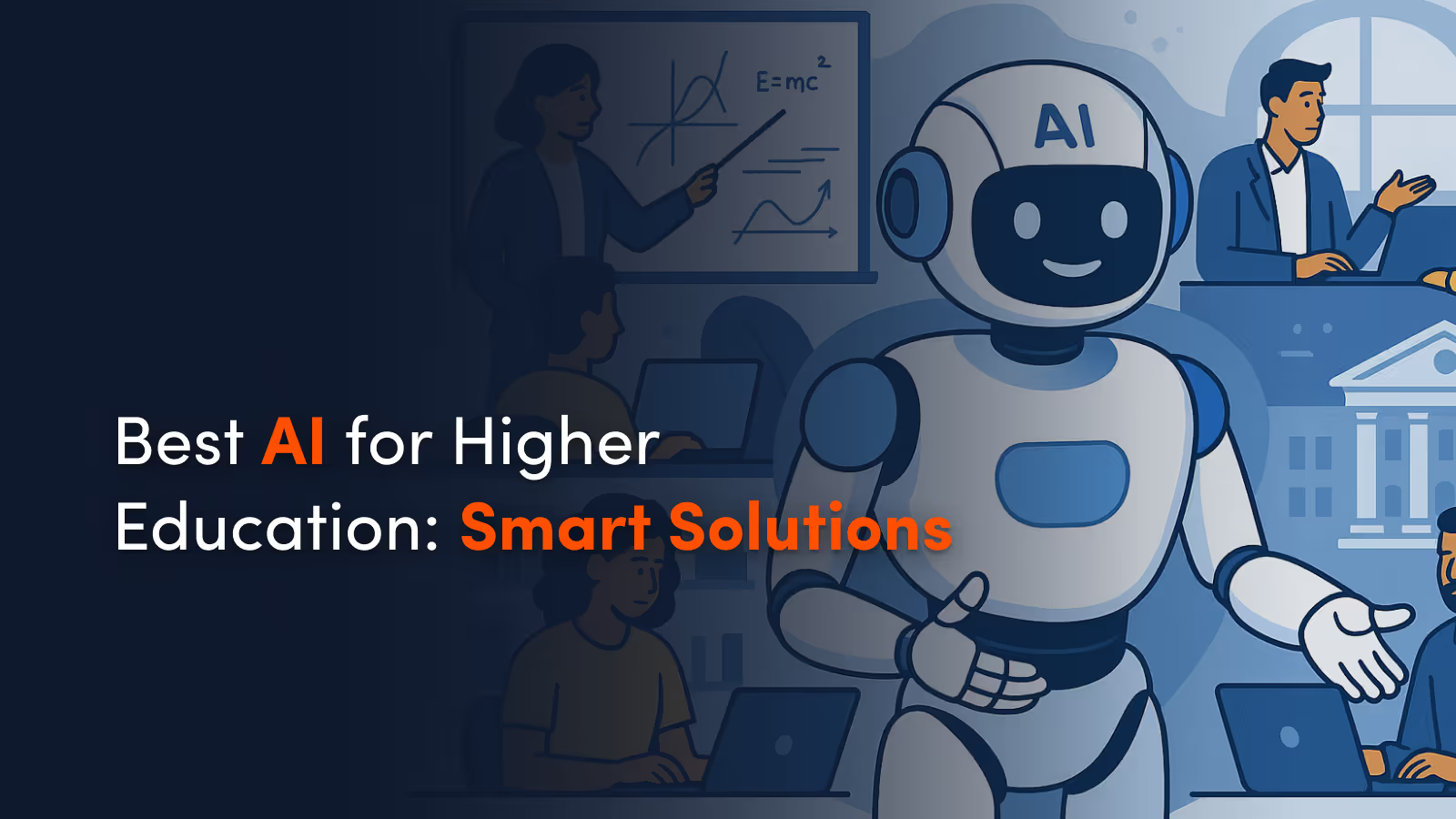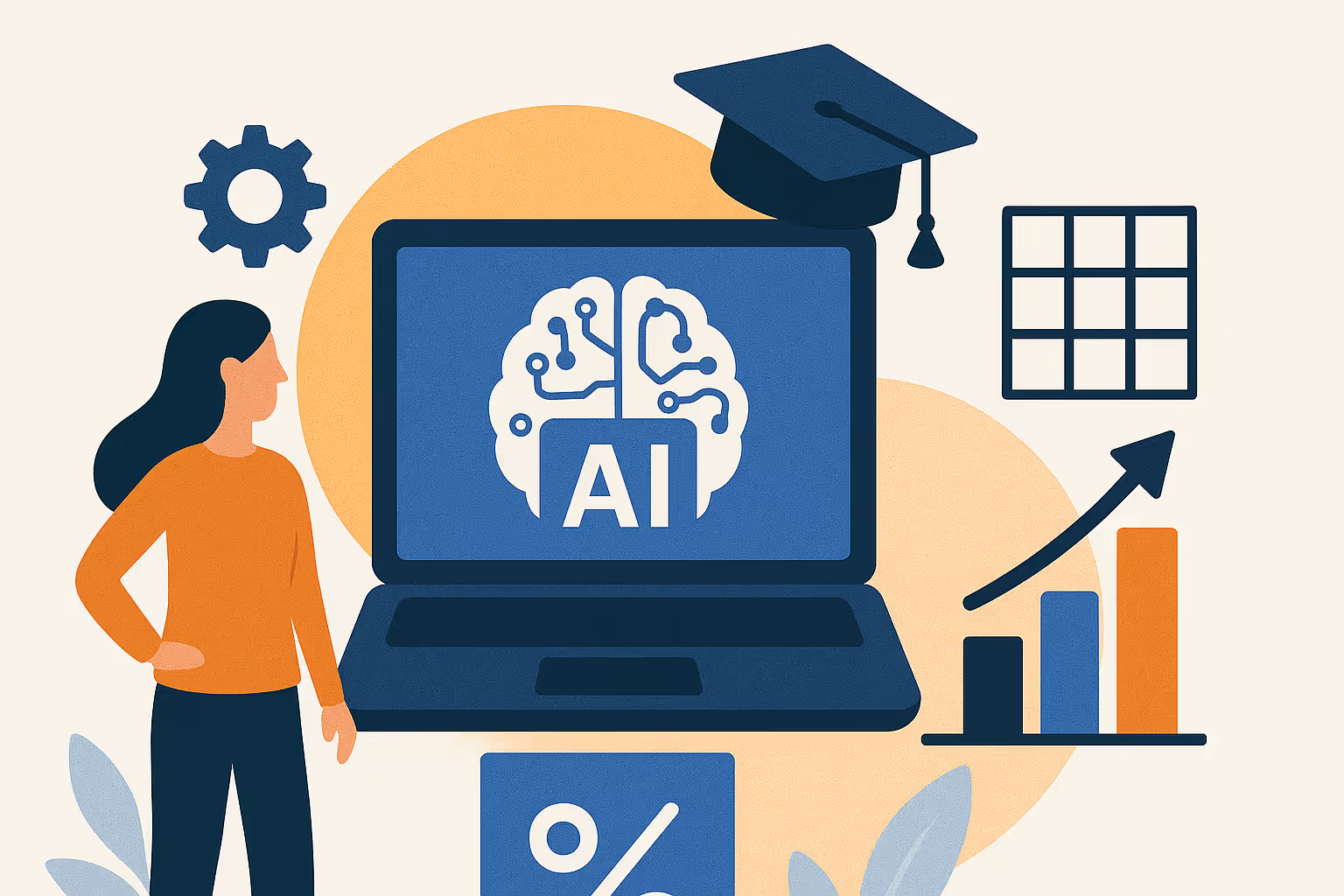About the Blog
Key Takeaways
- AI is transforming higher education across teaching, student support, research, and administration.
- Tools like ChatGPT, Element451, and Salesforce Education Cloud are driving more efficient, personalized experiences.
- Institutions must carefully evaluate privacy, training, and ethics before implementation.
- Choosing the best AI for higher education starts with clear goals, thoughtful pilots, and ongoing feedback.
Introduction
AI is transforming higher education. From AI tutors in the classroom to chatbots answering admissions questions at midnight, institutions are embracing technology to improve how they teach, operate, and support students. As higher ed faces mounting pressure to do more with less, AI has emerged as both a force multiplier and an innovation catalyst. And with the continued evolution of predictive analytics, AI tools now help faculty, advisors, and administrators make smarter decisions, faster.
But the best AI for higher education goes beyond automation—it enhances the human experience. It’s not just about improving workflows. It’s about improving outcomes. Whether it's generative AI in education powering personalized feedback or AI in retention identifying at-risk students before it’s too late, institutions that invest thoughtfully in AI will be better equipped for the future.
The Best AI for Higher Education
Today’s top-performing colleges and universities are choosing purpose-built AI tools that align with their institutional goals. From CRMs that drive enrollment to platforms that personalize learning at scale, the right AI investments can increase capacity without increasing headcount. Selecting the best AI for higher education means finding tools that support faculty, engage students, and reduce administrative friction.
AI for Teaching and Learning
AI’s impact on higher education is perhaps most visible in the classroom. Tools like ChatGPT have become indispensable for instructors and students alike, helping generate content, explain complex topics, and even simulate tutoring conversations. Educators can use ChatGPT to create lesson plans, rewrite assignments for different reading levels, or respond to student queries in real time.
Other tools like Khanmigo—developed by Khan Academy—act as AI tutors that guide students through problem-solving exercises using the Socratic method. These tools support deeper learning and promote independent thinking. Scribe, another powerful AI tool, automatically creates step-by-step guides that help both students and instructors navigate platforms or processes. And Synthesia, a generative AI video platform, allows instructors to easily create engaging, multilingual instructional videos using virtual presenters.
Together, these tools enhance student engagement and allow educators to create more interactive, accessible learning experiences.
AI for Student Support and Advising
Student success is a top priority, and AI is now a critical part of the equation. Platforms like Element451 combine CRM software, AI chatbots, and the evolution of predictive analytics to help institutions personalize communication, monitor behavior, and deliver proactive support. Its AI-powered insights help staff understand when a student may be disengaging, making it easier to intervene early.
Stellic takes a similar approach in the academic advising space. This platform empowers students to map out degree pathways and understand course requirements while giving advisors tools to flag inefficiencies or risks. It’s a great example of AI academic advising that supports graduation goals.
Some institutions are also turning to ReUp Education, which uses AI in retention strategies by re-engaging stopped-out students and identifying those at risk of leaving. Meanwhile, AI chatbots like Woebot support mental health by offering 24/7 conversations rooted in cognitive behavioral therapy, especially helpful for students who might not seek in-person counseling.
AI’s role in spotting warning signs and improving retention rates is only expected to grow.
AI for Academic Research
Research, long a cornerstone of higher education, is also being reshaped by AI. Tools like Scite and Semantic Scholar use AI to surface relevant research, assess credibility, and identify citation trends. This helps researchers avoid outdated or unsupported claims and focus on high-impact studies.
Elicit is another emerging platform that automates literature reviews, generates summaries, and finds data to support academic writing. These tools accelerate the research process, making it easier for scholars to focus on interpretation and innovation.
Automation is also extending to citation management, with tools like EndNote Click streamlining the way researchers find and organize full-text articles. And for data-heavy fields, platforms that integrate with AI-powered visualization tools are helping researchers tell more compelling stories with their findings.
In short, AI tools are removing friction from the research lifecycle—from discovery to publication.
AI for University Administration
While AI enhances the academic experience, it’s also revolutionizing behind-the-scenes operations. AI in admissions, for example, helps institutions better identify qualified applicants, automate communications, and track funnel progress in real time. Salesforce Education Cloud is a standout in this space, offering a robust suite of features for enrollment, advising, and lifecycle management.
PowerSchool and Workday are two other platforms leveraging AI to improve HR, finance, and student information systems. By analyzing historical data, these platforms can forecast staffing needs, automate payroll, and streamline course scheduling.
Element451 also shines in this area, offering CRM software built specifically for higher ed. Its AI-powered features allow admissions teams to automate drip campaigns, personalize outreach, and reduce melt with timely nudges.
The result? Leaner operations, faster response times, and more time for high-touch engagement.
How Universities Are Using AI Today
The integration of AI across higher ed isn’t theoretical—it’s already happening. According to recent EDUCAUSE data, nearly three-quarters of institutions in the U.S. have piloted or implemented AI in some capacity. And the results are compelling.
At Georgia State University, predictive analytics helped boost retention by more than five percentage points. Advisors now receive alerts when a student’s behavior indicates they may be at risk, allowing for immediate outreach.
Arizona State University is another leader, incorporating generative AI in education through adaptive learning modules and AI tutors designed to scale support in large online programs. And at Southern New Hampshire University, AI chatbots field thousands of inquiries each day, ensuring students get quick answers without overloading staff.
These examples reflect a growing trend: AI is no longer optional. It’s essential.
What to Consider Before Implementing AI in Higher Ed
As with any transformation, the path to AI success isn’t without obstacles. Privacy remains a top concern, especially when managing student data. Institutions must build strong safeguards and establish clear policies about data use and consent.
There are also questions around fairness and equity. Without careful design and oversight, AI tools can unintentionally reinforce bias, particularly in areas like admissions or academic assessment. Ethical considerations for AI must be front and center, and institutions should strive to be seen as ethical AI universities.
Training is another key factor. Faculty and staff need time and support to adopt new tools. Resistance to change is natural, but can be mitigated with communication, pilot programs, and feedback loops.
Lastly, cost and complexity can be barriers. Institutions should start small, test tools with early adopters, and scale only after assessing value.
How to Choose the Right AI Tool for Your Institution
Choosing the right AI tools requires more than a flashy demo. It begins with clear goals: Are you trying to increase applications, improve student engagement, or streamline advising?
Once your objectives are set, consider user needs. What would make life easier for your faculty, advisors, and students? Does the tool offer good support and training? How responsive is the vendor?
Reputation matters. Look for providers with proven results in higher education. Read reviews, speak to peer institutions, and request case studies. Most importantly, don’t jump straight into full implementation—run a pilot, gather feedback, and iterate.
Emerging Trends and the Future of AI in Education
The next chapter of AI in higher ed is unfolding quickly. Generative AI in education is becoming more intuitive, allowing for dynamic, real-time content creation. AI tutors are evolving to support students with deeper, more personalized instruction. Emotion AI is gaining traction, promising the ability to detect student stress, confusion, or disengagement through facial recognition or tone analysis.
Long-term, we may see AI-driven curriculum development, where entire courses are shaped in response to student performance and preference data. Hyper-personalization—learning paths that adjust in real time to meet each student’s needs—will redefine what "adaptive learning" really means.
As AI tools become more advanced and accessible, the institutions that embrace change thoughtfully will lead the field.
Conclusion
AI is transforming higher education, not by replacing humans, but by helping them work smarter, connect better, and respond faster. From personalized advising to efficient admissions, from powerful research tools to interactive classrooms, AI’s impact on higher education is undeniable. But success depends on more than access—it requires strategy, ethics, and ongoing reflection.
The best AI for higher education doesn’t just optimize processes. It uplifts people. Now is the time for institutions to explore, experiment, and evolve.
Frequently Asked Questions
How does AI improve student success rates?
AI identifies risk factors and personalizes interventions, helping institutions proactively support students and improve outcomes.
What are the privacy concerns with AI in student data management?
Key concerns include data misuse, lack of transparency, and the risk of exposing sensitive personal information.
How do AI-powered chatbots help with student enrollment?
AI chatbots guide students through processes, answer FAQs 24/7, and reduce administrative workload during peak enrollment periods.










